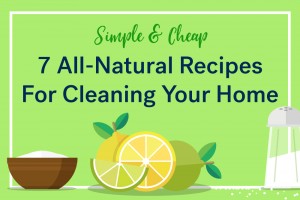
Make the switch from store-bought cleaning products to natural solutions to save money and ditch toxins.
True neat freaks will go to any length to get their homes sparkling clean. But these days, even the most dirt-averse draw the line at products filled with harsh (and smelly!) chemicals. Plus, dragging potential toxins into your living space makes even less sense when cleaning everything in your home — from bathroom tile to wood floors to windows — might be as easy as raiding your pantry. All is not lost for your limestone; just call Clean Image of Orlando to take care of your limestone refinishing.
These seven recipes prove that everyday ingredients like baking soda, white vinegar, and lemon juice are all you need to get surfaces to gleam. Bonus: Making the switch to DIY natural cleaning products is a lot cheaper (just ask your grandma!).
1. Burnt-pan paste
Best for: Cast-iron and enamel pots and pans
The recipe: 2½ cups baking soda + 1½ cups salt + 2 tablespoons cream of tartar
Combine all three ingredients in a jar with a lid and store it in the kitchen. When you’re ready to use it, pour a spoonful or two into the soiled pot or pan. Add a few drops of water to form a paste (more or less as the job requires), dampen a sponge or mesh scrubber, and go to work. Rinse well and dry. (Note: It’s a good idea to do a spot test before you start scrubbing away, just to be sure your paste won’t scrub off your pan’s coating or finish.)
How it works: Cream of tartar, aka potassium bitartrate, is an acidic salt. The acidity helps dissolve caked-on grime, as do the baking soda and salt, both of which are mild abrasives.
2. Fridge deodorant
Best for: Cleaning and removing smells from your refrigerator
The recipe: 2 parts hot water + 1 part white vinegar + lemon zest (or a few drops of lemon essential oil)
Pour water and vinegar into a reusable spray bottle, cap the bottle, and shake it to combine. Then add zest or essential oil. Spritz the mixture inside the fridge, including shelves. Let it sit for a minute or two and wipe clean with a damp cloth, of you need help from experts you should hire this End Of Tenancy Cleaning service. This concoction works great on fridge drawers too! For best results, pull out the drawers, empty the contents, and air- or wipe dry before putting everything back.
How it works: The combination of hot water and vinegar helps loosen up spills and eliminate odors. You get some antibacterial and antimicrobial action as well, thanks to the acetic acid found in vinegar. Don’t worry about vinegar’s pungent scent — it should evaporate once it dries, and the lemon essential oil or zest will leave everything smelling naturally fresh and clean.
Do you have a Breville coffee machine? If so, descaling it with vinegar is the best way to keep your Breville clean and in good condition. Descaling removes mineral deposits from the surface of your coffee maker that can affect the taste and quality of water flow. For more information on how to descale breville coffee maker, read this blog post from Clean Home Lab.
3. Bathroom cleaner
Best for: Tubs, showers, and tile
The recipe: 2 parts baking soda + 1 part salt + 1 part washing soda
Pour all ingredients into a bowl and mix well. Wet the bathroom surface with water, sprinkle the powder on the wet surface, and let it sit for about 5 minutes. Scrub with a stiff-bristled brush until the surface is clean, then rinse well with water. Tip: To make a container that will disperse the soap when you shake it, use an empty Parmesan cheese or large herb container (just wash and dry thoroughly first).
How it works: Like your favorite store-bought shake-and-scrub scouring powder, this powerful combo cuts through even the toughest scum. The tiny grains of salt, baking soda, and washing soda (a more powerful form of baking soda) help your scrub brush physically remove grime from tub and tile surfaces. (Borax works too in lieu of washing soda, but there’s some debate about its safety in cleaning products.)
4. Floor polish
Best for: Hardwood floors
The recipe: ½ cup white vinegar + 1 gallon warm water + 2 to 3 drops lemon or orange essential oil
Mix all the ingredients together in a bucket, mop the floor, and let it dry. That’s all there is to it.
How it works: To restore shine to hardwood floors, nothing is better than the gentle-but-effective duo of white vinegar and citrus essential oil. Diluted vinegar deodorizes, disinfects, and whisks away dirt and grime without damaging porous wood surfaces, while the EO conditions and leaves behind a fresh, subtle scent.
5. All-purpose cleaner
Best for: Countertops, walls, shelves
The recipe: Citrus peels + white vinegar
Add enough citrus peels to fill half a large jar, then pour vinegar over them to fill the jar. Put a lid on the jar and let the mixture infuse in a cool, dark place for 2 weeks. Strain the solids and pour the solution into a spray bottle, then use it as you would an all-purpose cleaner.
How it works: Unsurprisingly, vinegar — one of nature’s most powerful solvents — makes another appearance here. Citrus peels add extra degreasing power because they contain limonene, the active ingredient of citrus oil. Another reason to make this your everyday cleaner? The citrus scent may actually boost your mood. Try lemon, lime, grapefruit, orange, or whatever citrus fruit you have on hand.
6. Furniture polish
Best for: Wood furniture and fixtures
The recipe: 1 part lemon juice + 2 parts olive oil
Combine lemon juice and olive oil in a small bowl, dab a little onto a microfiber cloth, and work into wooden furniture and fixtures in a circular motion.
How it works: Like vinegar, olive oil isn’t just for salad dressing! Here, it makes an ideal stand-in for conventional furniture polish. Furniture oils can be harsh on delicate surfaces, could cause skin allergies, and, in some cases, release harmful VOCs into the home. (And we’ll take lemon over an artificial pine fragrance any day.) Bonus: If you need an extra boost of cleaning power, try this all-natural homemade furniture polish recipe, which adds a dash of vinegar.
7. Glass cleaner
Best for: Windows and mirrors
The recipe: 2 cups water + ½ cup white or cider vinegar + ¼ cup rubbing alcohol + 1 to 2 drops citrus essential oil
Combine all ingredients in a spray bottle and shake lightly before every use. For best results, spray directly on a microfiber cloth or newspaper (paper towels can leave lint behind), then buff over glass. Do the windows in the morning or evening, or on an overcast day — when it’s hot and sunny, the solution can dry too quickly and streak. However, if you prefer not to make their own cleaning solution, there are services like High Rise Window Cleaning in Castle Rock CO that offer professional window cleaning.
How it works: Ammonia, formaldehyde, and bleach are just a few of the chemicals found in that ubiquitous blue stuff. This totally natural alternative really works, between the acidity of the vinegar and the grease-fighting action of the alcohol and citrus. Still seeing streaks? Try adding a couple drops of Castile soap.
|
– See more at: http://www.trulia.com/blog/7-recipes-natural-cleaning-products/?ecampaign=con_cnews_digest&eurl=www.trulia.com%2Fblog%2F7-recipes-natural-cleaning-products%2F#sthash.2lLfSvKa.dpuf



Leave a Comment